2. STAR-FORMING REGIONS
The brightest, hottest stars must be very young compared to the Sun, because (as you will see later in this course) they have very short lifetimes (less than 100 million years) compared to the Sun's age (about 5 billion years). When we see such hot stars, we always see them in
clusters containing hundreds or thousands of stars. The most prominent such cluster in the sky is the Pleiades in the constellation Taurus. (The Japanese name for this cluster is Subaru; every Subaru car has a chrome Pleiades.) Moreover, we always find these young clusters near to molecular clouds. Often, we find that such hot stars are buried within the molecular clouds. When the clouds contain such stars, we see that the radiation from the stars is causing the dense gas to disperse into interstellar space. Clearly, the dense clouds are the birthplaces of new stars.
The most famous star-forming region in the Milky Way (about 1000 light years from the Sun) star-forming region is the
Orion Nebula (also called M42, which means it is object number 42 in the famous catalogue of nebulae compiled by Charles Messier in 1782. M42 is the middle object in the "sword" of the constellation Orion. With binoculars, you can see that it is a fuzzy object, not a star. Much of what we know about star formation comes from observations of this nebula. Below is a photo tour of Orion. (For larger images, click on the source hyperlinks.)
|
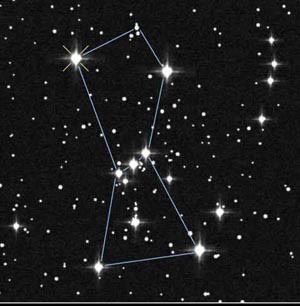
|
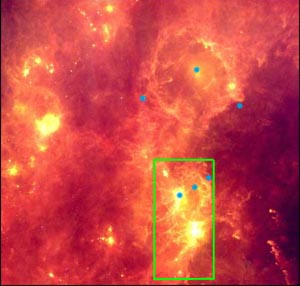
|
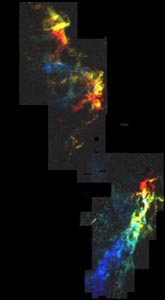
|
|
The constellation Orion. Betelgeuse is the bright star at the upper left. The Orion Nebula is the bright smudge below the three stars of Orion's belt. |
The infrared sky in the direction of Orion. The bright emission comes from dust grains heated by starlight. The blue dots indicate the positions of the bright stars, with Betelgeuse at the upper center. The Orion Nebula is the bright yellow blob at the lower right. The green box indicates the field of view of the image to the right. Source: APOD |
Radio emission from cold carbon monoxide gas in the direction of Orion. Red and blue indicate Doppler shifts. Source: |
|
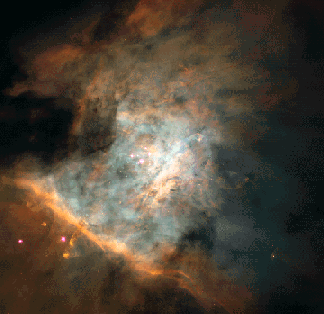
|

|
|
The Orion Nebula in optical light, from the Hubble Space Telescope. The bar at the lower left is a wall of gas viewed edge-on. This gas glows because it is ionized by the four hot "Trapezium stars" just to the left of center. Source: Crucible of Creation |
The Orion Nebula in infrared light. The bar at the lower left is less prominent, but we see a bright nebula in the upper right that is not seen in the visible image to the left. The orange represents infrared line emission from hydrogen molecules being blown away by a powerful embedded star (see below). Source: Subaru Telescope. |
|
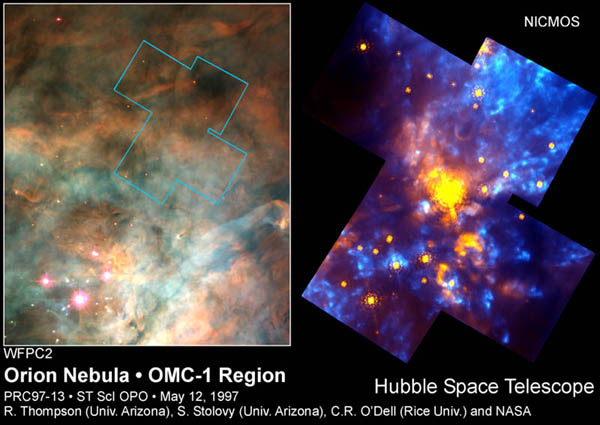
|
|
Left: a closer view of the Orion Nebula in optical light from the Hubble Space Telescope. The trapezium stars are clearly visible. The blue outline shows the field of view of the infrared image on the right. |
Right: the inset region in the image on the left viewed in infrared light by the NICMOS camera on the Hubble Space Telescope. We see a cluster of newborn stars buried within the dust cloud beneath the optical nebula. Source: NICMOS Captures the Heart of OMC-1 |
|
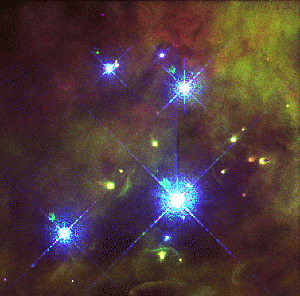
|
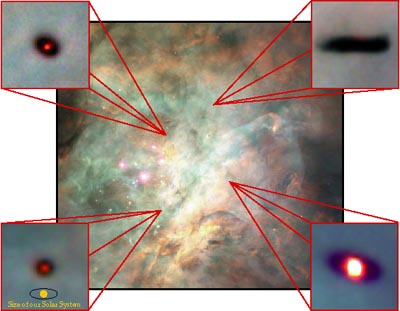
|
|
Close-up of the Trapezium stars, showing "cometary globules" of gas, evidently newly forming planetary systems being illuminated by the bright star at the lower right. Source: Doug Johnstone's Orion Page |
The insets show close-up views of "proplyds" -- protoplanetary disks in the Orion Nebula. The dark disks of dust are seen in silhouette against the bright glow of the Nebula. Upper left: a face-on disk with a central star like the Sun. Upper right: the central star is obscured by a thick edge-on disk. Lower left: another face-on system; the scale of our Solar System is indicated below. Source: APOD |
Two wonderful movies (source:
Space Telescope Science Institute) summarize much of what you have seen in the gallery above. The first, OrionAnim, zooms from a view of the entire Orion constellation into the Orion Nebula, then into protoplanetary disks. The second, OrionIR, zooms in on an optical image of the Orion Nebula, then fades into an infrared image from the NICMOS camera that shows the embedded star cluster.
The optical emission nebula that you see in the above images of Orion is caused mostly by ultraviolet light from a group of four bright blue stars called the "Trapezium". These stars, and the optical nebula, lie on the near side of a giant dark molecular cloud (called Orion Molecular Cloud 1, or OMC-1) that contains many newborn stars. At infrared wavelengths, we can see these embedded stars. The best such view that we have obtained to date comes from the new infrared camera (called NICMOS) that was recently installed on the Hubble Space Telescope. In May 1997, the Space Telescope Science Institute posted these results on a web page called
NICMOS Captures the Heart of OMC-1.
By observing Orion at specific radio and infrared wavelengths, we can see emission due to particular atoms or molecules that are present at specific locations inside the OMC. For example, have a look at the composite image of the
Orion Bar's photo-dissociation region, where you can see that the emission from warm carbon monoxide (red) is separated from the hot molecular hydrogen (green) and the warm dust grains (blue). UV radiation from hot stars to the upper right of this image are heating and destroying the dust grains and molecules. The CO is easiest to destroy, so it shows up furthest from the stars. The molecular hydrogen is somewhat more durable and is seen closer to the stars, and the grains, closer yet.
At the highest magnification of the HST optical images of Orion, we can see little comet-shaped gas clouds, called "cometary globules", and little dark disks, called "proto-planetary disks", or "proplyds" (see
Doug Johnstone's Orion Page). These are dense disks of gas and dust swirling around newly forming stars. We suspect that planetary systems will form from the dust in these disks. In some cases, the objects have tails of luminous gas pointing away from nearby hot stars, just as comet tails point away from the Sun. But these objects are not just comets -- they are whole planetary systems in the making. Their radii are a few hundreds of AU (1 AU is the distance from the Earth to the Sun). We believe that planets form in these swirling disks of gas and dust.
Besides the Orion Nebula, the Milky Way galaxy contains many more star-forming regions and many of the pictures are spectacular. The best one I know of is the Hubble Space Telescope Picture of the
Eagle Nebula (M16), shown below.
|

|
|
In this image of the Eagle Nebula, taken with the Hubble Space Telescope, new stars and planetary systems are forming inside the dark pillars of dense cold molecular gas. Ultraviolet light from the hot young stars heats the gas at the surfaces of the dark clouds to several thousand degrees, causing it to glow and expand away from the clouds. The little polyps projecting from the pillars are newly formed stars, surrounded by dense gas clouds that will eventually evolve into planetary systems. |
With the Hubble Space Telescope, astronomers have seen other star forming regions that are very similar to the Eagle Nebula. For example, have a look at this
Movie of the Trifid Nebula. (Source).
You can also find infrared images of several star-forming regions in the
IPAC Gallery.
(Return to course home page)
Last modified October 31, 2000
Copyright by Richard McCray

